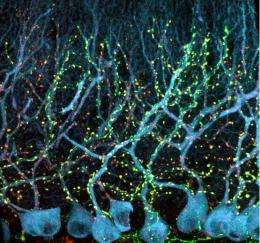Scientists reverse disorder of neuronal circuits in autism

People with autism suffer from a pervasive developmental disorder of the brain that becomes evident in early childhood. Peter Scheiffele and Kaspar Vogt, Professors at the Biozentrum of the University of Basel, have identified a specific dysfunction in neuronal circuits that is caused by autism. In the respected journal Science, the scientists also report about their success in reversing these neuronal changes. These findings are an important step in drug development for the treatment for autism.
According to current estimates, about one percent of all children develop an autistic spectrum disorder. Individuals with autism may exhibit impaired social behavior, rigid patterns of behavior and limited speech development. Autism is a hereditary developmental disorder of the brain. A central risk factor for the development of autism are numerous mutations in over 300 genes that have been identified, including the gene neuroligin-3, which is involved in the formation of synapses, the contact junction between nerve cells.
Loss of neuroligin-3 interferes with neuronal signal transmission
The consequences of neuroligin-3 loss can be studied in animal models. Mice lacking the gene for neuroligin-3 develop behavioral patterns reflecting important aspects observed in autism. In collaboration with Roche the research groups from the Biozentrum at the University of Basel have now identified a defect in synaptic signal transmission that interferes with the function and plasticity of the neuronal circuits. These negative effects are associated with increased production of a specific neuronal glutamate receptor, which modulates the signal transmission between neurons. An excess of these receptors inhibits the adaptation of the synaptic signal transmission during the learning process, thus disrupting the development and function of the brain in the long term.
Of major importance is the finding that the impaired development of the neuronal circuit in the brain is reversible. When the scientists reactivated the production of neuroligin-3 in the mice, the nerve cells scaled down the production of the glutamate receptors to a normal level and the structural defects in the brain typical for autism disappeared. Hence, these glutamate receptors could be a suitable pharmacological target in order to stop the developmental disorder autism or even reverse it.
Vision for the future: Medication for autism
Autism currently cannot be cured. At present, only the symptoms of the disorder can be alleviated through behavioral therapy and other treatment. A new approach to its treatment, however, has been uncovered through the results of this study. In one of the European Union supported projects, EU-AIMS, the research groups from the Biozentrum are working in collaboration with Roche and other partners in industry on applying glutamate receptor antagonists for the treatment of autism and hope, that in the future, this disorder can be treated successfully in both children and adults.
More information:
Baudouin S. J., Gaudias J., Gerharz S., Hatstatt L., Zhou K., Punnakkal P., Tanaka K. F., Spooren W., Hen R., De Zeeuw C.I., Vogt K., Scheiffele K.
Shared Synaptic Pathophysiology in Syndromic and Non-syndromic Rodent Models of Autism, Science, Published online September 13 (2012) doi: 10.1126/science.1224159




















